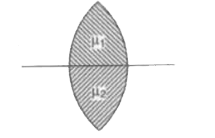एक वस्तु एक घर्षणरहित नत समतल पर प्रारम्भिक विरामावस्था से नीचे ओर सरकती है। यदि sn और sn+1 क्रमशः वस्तु द्वारा n वें और (n+1) वें सेकण्ड में चली गई दूरियाँ हो तो sn+1sn अनुपात है
2n−12n+1
2n2n+1
2n+12n−1
2n2n−1
The correct Answer is:C
संकेत एक समान त्वरित वस्तु के लिए η वें सेकण्ड में चली गई दुरी निम्न समीकरण द्वारा दी जाती है।
Sn=u+12a(2n−1)
प्रश्नानुसार एक वस्तु एक घर्षणरहित नत समतल पर प्रारम्भिक विरामावस्था से नीचे की ओर सरकती है, जैसा कि नीचे चित्र में दर्शाया गया है।

∴n वें सेकण्ड में चली गई दुरी
Sn=u+12(gsinθ)(2n−1)
(यहाँ प्रारम्भिक वेग, u=0 )
⇒Sn=gsinθ2(2n−1) ......(i)
इसी प्रकार (n +1) वें सेकण्ड में चली गई दुरी
Sn+1=gsinθ2[2(n+1)−1]
Sn+1=gsinθ2(2(n+1) ......(ii)
सभी (i) व (ii) से n वें और (n +1) वें सेकण्ड में चली गई दूरियों का अनुपात
Sn+1Sn=⎡⎢⎣gsinθ2(2n+1)gsinθ2(2n−1)⎤⎥⎦2n+12n−1
Topper's Solved these Questions
Similar Questions
एक कार्नोट चक्र में कार्यशील पदार्थ T1 तापक्रम पर Q1 उष्मा अवशोषित करता है तथा T2 तापक्रम पर Q2 उष्मा मुक्त करता है । कार्नोट चक्र के दौरान होने वाला एंट्रोपी परिवर्तन है
View Solutionनिम्नलिखित में से कौन अनंत से आने वाली किरणों के लिए सत्य है ?

View SolutionLet Sn=1+2+3++n and Pn=S2S2−1⋅S3S3−1⋅S4S4−1⋅⋅⋅SnSn−1 Where n∈N,(n≥2). Then limx→∞Pn=______
View SolutionS_(n)=sum_(n=1)^(n)(n)/(1+n^(2)+n^(4)) then S_(10)S_(20)
View SolutionLet Sn,n=1,2,2.... be the sum of infinite geometric series whose first term is n and the common ratio is . 1n+1.Evaluate Limn→∞S1Sn+S2Sn−1+S3Sn−2+.....+SnS1S21+S22+....+S2n
View SolutionSN1andSN2 reactions are
View SolutionIf Sn denotes the sum of first n terms of an A.P., then
S3n−Sn−1S2n−Sn−1 is equal to
View SolutionIf Sn=1+12+13+…+1n(n∈N), then prove that
S1+S2+..+S(n−1)=(nS((n))−n)or(nS((n−1))−n+1)
View SolutionLet Sn,n=1,2,3,… be the sum of infinite geometric series, whose first term is n and the common ratio is 1n+1. Evaluate limn→∞S1Sn+S2Sn−1+S3Sn−2+...+SnS1S21+S22+......+S2n.
View SolutionIf S_(n) denotes the sum of first 'n' natural numbers then s_(1)+S_(2)x+S_(3)x^(2)+.........+S_(n) x^(n-1)+......oo=(1-x)^(-n) then n is
View SolutionIf s_(n) denotes the sum of first 'n' natural numbers then S_(1)+S_(2)x+S_(3)x^(2)+.........+S_(n)x^(n-1)+......oo=(1-x)^(-n) then n is
View SolutionLet Sn=1+2+3+...+n and Pn=S2S2−1.S3S3−1.S4S4−1...SnSn−1, where n∈N,(n≥2)Thenlimn→∞Pn=__________.
View SolutionIf Sn=1+12+13+…+1n(n∈N), then prove that
S1+S2+..+S(n−1)=(nS((n))−n)or(nS((n−1))−n+1)
View SolutionSn=1+2+3+....+nn then S21+S22+S23+.....+S2n=
View Solutionयदि Un=n!(n+2)! जहाँ n∈N, यदि Sn=n∑n=1Un हो तो Limn→∞Sn बराबर है
View SolutionLet Sn,n=1,2,3,… be the sum of infinite geometric series, whose first term is n and the common ratio is 1n+1. Evaluate limn→∞S1Sn+S2Sn−1+S3Sn−2+...+SnS1S21+S22+......+S2n.
View Solution
